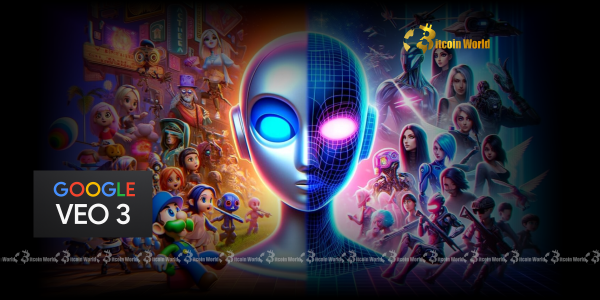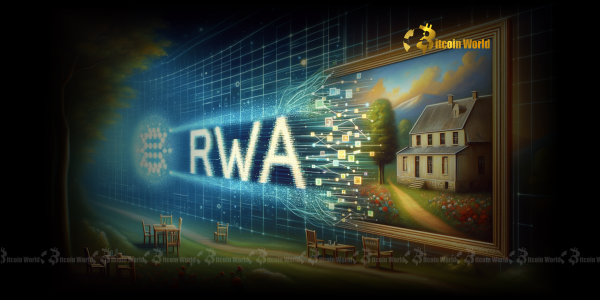BitcoinWorld

Google AI’s Veo 3: Pioneering the Future of Playable World Models
In a digital age where innovation reshapes our realities, the whispers from Google’s AI division are echoing through the virtual halls, hinting at a convergence that could redefine interactive entertainment. For those who navigate the evolving landscape of digital assets and decentralized worlds, the concept of a ‘playable world model’ isn’t just a technological marvel; it’s a potential new frontier for digital ownership, immersive experiences, and perhaps even novel economic models within virtual spaces. Could Google AI be on the verge of unlocking truly dynamic, player-driven universes?
The recent exchange on X between a curious user, DeepMind CEO Demis Hassabis, and Google AI Studio lead Logan Kilpatrick has ignited a fervent discussion. The user’s playful plea, “let me play a video game of my veo 3 videos already,” and the follow-up, “playable world models wen?” were met with Hassabis’s intriguing response, “now wouldn’t that be something,” swiftly followed by Kilpatrick’s cryptic “


 ”. While Google spokespersons maintain there’s nothing concrete to share, these suggestive comments from high-ranking executives are fueling speculation about the future of AI Gaming and interactive digital environments.
”. While Google spokespersons maintain there’s nothing concrete to share, these suggestive comments from high-ranking executives are fueling speculation about the future of AI Gaming and interactive digital environments.
What Exactly Are Playable World Models, and Why Are They a Game-Changer?
To truly grasp the significance of these hints, it’s crucial to understand the distinction between different types of AI models. At its core, a ‘world model’ is an AI system designed to simulate the dynamics of a real-world environment. Imagine an AI that can predict how its actions will affect the world around it, learning cause and effect. This capability allows agents to anticipate outcomes and plan complex sequences of actions, much like a human brain navigating its surroundings. These models are fundamental to creating truly intelligent agents that can operate autonomously and effectively within dynamic environments.
In contrast, ‘video generation models’ like Google’s latest Veo 3 primarily synthesize realistic video sequences. They are incredibly adept at creating visually stunning and coherent clips, but their output is generally ‘passive.’ They generate what they are prompted to, without necessarily understanding the underlying physics or interactive potential of the scenes they create. While immensely powerful for content creation, they aren’t inherently built for real-time, player-driven interaction.
The potential for playable world models lies in bridging this gap. If an AI can not only generate realistic visuals but also simulate the physics and consequences of actions within those visuals, it opens up possibilities for truly interactive and emergent gameplay. Instead of pre-scripted narratives, players could engage with environments that dynamically respond to their every choice, creating unique and unrepeatable experiences.
Veo 3’s Role: More Than Just Pretty Pictures for AI Gaming?
Google’s Veo 3, currently in public preview, is an impressive piece of technology. It can generate not just video but also accompanying audio, from speech to intricate soundtracks. A key feature is its ability to create realistic movements by simulating real-world physics, giving its generated videos a high degree of fidelity. However, as noted in the original discussions, Veo 3 isn’t yet a full-fledged world model. It excels at cinematic storytelling, making it ideal for:
- Game Cutscenes: Crafting stunning, immersive narrative sequences.
- Trailers: Producing captivating promotional material with ease.
- Narrative Prototyping: Quickly visualizing story ideas and character interactions.
For AI Gaming to truly evolve, a model like Veo 3 would need to transition from a ‘passive output’ generator to an ‘active simulator.’ This shift would involve enabling real-time interaction, predictive capabilities, and consistent environmental responses to player input. While Veo 3 currently simulates physics for visual realism, a playable world model would need to apply those physics dynamically and consistently based on user actions, allowing for genuine interaction and emergent gameplay.
DeepMind’s Ambitious Vision: Crafting the Brains of Future Worlds
The pursuit of advanced AI models that can simulate complex environments is not new territory for Google, particularly for its AI research powerhouse, DeepMind. Their long-term vision extends far beyond mere video generation. DeepMind has explicitly stated plans to evolve its multimodal foundation model, Gemini 2.5 Pro, into a comprehensive world model capable of simulating aspects of the human brain itself. This ambitious undertaking suggests a fundamental shift towards AI that can truly understand and interact with complex systems.
Evidence of this trajectory is already visible:
- Genie 2: In December, DeepMind unveiled Genie 2, a model specifically designed to generate an ‘endless’ variety of playable worlds. While distinct from Veo 3, Genie 2 represents a significant step towards creating interactive environments.
- Dedicated AI Simulation Team: Earlier this year, reports confirmed Google was forming a new team dedicated to developing AI models capable of simulating the real world. This dedicated focus underscores the strategic importance Google places on this domain.
This internal synergy within DeepMind suggests a potential hybrid approach for future game development. Leveraging Veo 3’s visual prowess for stunning graphics and cinematic elements, combined with Genie 2’s ability to generate interactive worlds and Gemini’s foundational understanding, could lead to a powerful platform for creating unprecedented gaming experiences. This strategic alignment could position Google AI at the forefront of this emerging field.
Navigating the Challenges: The Road to Truly Interactive Google AI Worlds
While the prospects are exciting, building truly interactive playable world models for video games presents significant challenges. The core difficulty isn’t just about generating impressive visuals; it’s about achieving real-time, consistent, and controllable simulation. Games demand instant feedback, predictable yet dynamic physics, and the ability for players to directly influence the world without breaking immersion. This level of responsiveness and coherence is far more complex than generating a pre-rendered video sequence.
Consider the computational demands: simulating an entire world, its characters, objects, and their interactions in real-time requires immense processing power. Furthermore, ensuring logical consistency across vast, player-driven environments is a monumental task. Bugs, glitches, and illogical behaviors can quickly shatter the illusion of a living, breathing world.
The competitive landscape is also heating up. Google is not alone in this pursuit. Companies like Microsoft, Scenario, Runway, and Pika are actively developing generative AI for creative applications, with OpenAI’s Sora also poised to be a significant player in video generation. Google’s historical approach of leveraging its deep pockets and extensive distribution network to dominate new markets suggests that competitors in the AI Gaming space would be wise to closely monitor Google’s advancements in playable world models. The race to define the next generation of interactive entertainment is clearly on.
The Transformative Impact on Entertainment and Beyond
The implications of truly playable world models extend far beyond just video games. Imagine the potential for:
- Interactive Education: Learning environments that adapt and respond to a student’s actions, allowing for hands-on exploration of complex concepts.
- Realistic Simulations: Training environments for professionals in fields like medicine, aviation, or engineering, offering highly realistic and adaptable scenarios.
- Creative Exploration: Artists and designers could rapidly prototype and iterate on ideas within dynamic, simulated spaces.
- Virtual Commerce: Fully interactive virtual marketplaces where products can be physically manipulated and experienced before purchase.
The ability of Google AI to create and manage these complex simulations could unlock entirely new industries and redefine existing ones. The initial focus on gaming is a natural starting point, as it provides a clear framework for interaction and immediate user feedback, pushing the boundaries of what these models can achieve.
Conclusion: Is the Future of Playable Worlds Already Here?
While Demis Hassabis and Logan Kilpatrick’s comments remain speculative, they offer a tantalizing glimpse into Google’s strategic direction. The convergence of advanced video generation models like Veo 3 with the burgeoning field of playable world models, spearheaded by DeepMind, suggests a future where digital environments are not just viewed but truly inhabited and shaped by users. The journey from passive video to interactive, responsive worlds is complex, but Google’s significant investments and the clear technological advancements indicate that the era of truly dynamic AI Gaming may be closer than we think. The question isn’t if these worlds will become playable, but when, and what incredible experiences they will unlock.
To learn more about the latest AI market trends, explore our article on key developments shaping AI Models features.
This post Google AI’s Veo 3: Pioneering the Future of Playable World Models first appeared on BitcoinWorld and is written by Editorial Team





